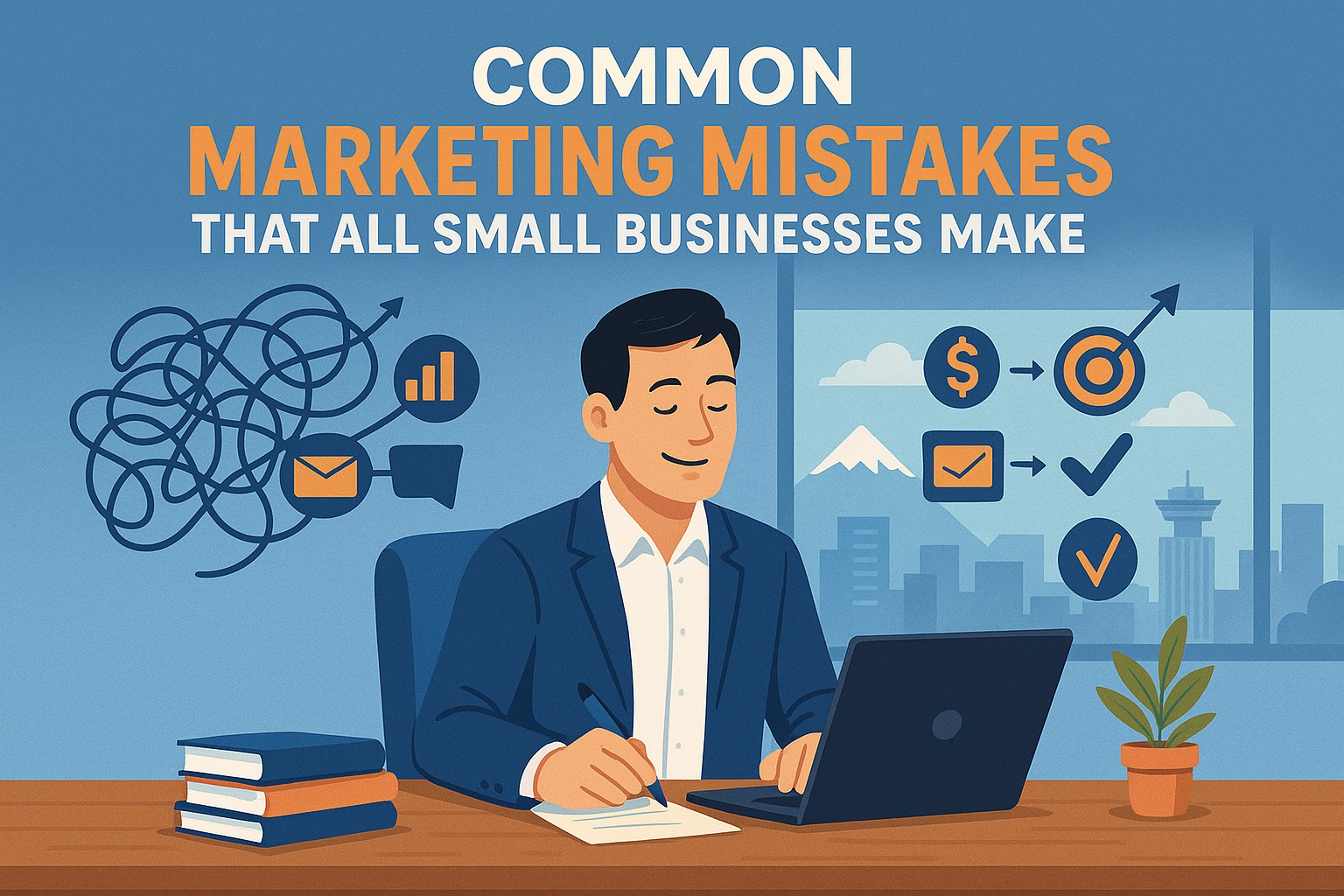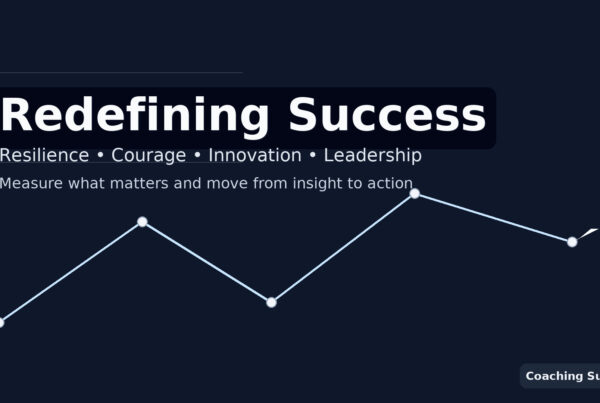7 Common Marketing Mistakes That All Small Businesses Make (And How to Fix Them in Canada)
If you run a small business in Western Canada, you’ve probably had this thought:
“We’re good at what we do. So why isn’t our marketing bringing in more leads?”
You’re not alone. From Vancouver to Kelowna to Calgary, most entrepreneurs didn’t start their business because they love marketing. They started it because they’re great at their craft. Marketing came later — usually in the form of “let’s just get something out there and hope it works.”
The result? A lot of effort, not a lot of results.
The encouraging part is this: it’s not that you’re bad at marketing. It’s that most small businesses fall into the same, predictable marketing mistakes. Once you see them, you can fix them.
Let’s walk through seven common marketing mistakes that all small businesses make — and exactly how to turn each one into a strength.
Why Small Business Marketing Feels So Hard Right Now
The reality for Canadian entrepreneurs in Western Canada
Running a business in Canada today means:
-
Rising costs (rent, wages, supplies)
-
Fierce local and online competition
-
Limited time and budget for marketing
At the same time, you’re bombarded with advice:
-
“You have to be on TikTok.”
-
“SEO is the only thing that matters.”
-
“If you’re not running ads, you’re invisible.”
It’s confusing and exhausting. Many owners in Western Canada are juggling operations, hiring, cash flow, and then trying to fit marketing into the cracks of their day.
The good news: your marketing isn’t broken, it’s just unfocused
Most of the time, the problem isn’t that your business is unmarketable. It’s that:
-
Your message is too broad.
-
Your efforts are scattered across too many tactics.
-
You aren’t measuring what’s actually working.
Once you tighten those pieces up, lead generation becomes simpler and more predictable.
If you’re reading this and thinking, “This is exactly where I’m stuck,” you don’t have to untangle it alone.
If this feels a little too familiar and you’d like a fresh pair of eyes on your marketing, book a free 15-minute strategy call with me. In one short conversation, we’ll identify your biggest quick win for the next 30 days.
👉 Book your call here
Let’s start with the biggest trap of all.
Mistake #1: Trying to Market to “Everyone”
Why “everyone” is not a strategy
If your answer to “Who is your ideal client?” is “Anyone who needs what we offer,” you’re not alone — but it’s costing you.
When you try to speak to everyone, your marketing:
-
Sounds generic and forgettable
-
Doesn’t resonate deeply with anyone
-
Attracts price shoppers instead of ideal clients
Many small business owners later realize that their best clients share clear traits: industry, location, size, and values. But their marketing still talks to a vague “everyone.”
How to fix it: build a one-page Ideal Client Snapshot
You don’t need a 20-page persona document. Create a simple one-page Ideal Client Snapshot:
-
Name them
-
“Growth-minded home services business owner in Greater Vancouver.”
-
“HR manager at a 50–200-person manufacturing company in BC.”
-
-
List their top 3 pains
-
“Too few leads.”
-
“Unpredictable revenue.”
-
“No time for marketing.”
-
-
List their top 3 desired outcomes
-
“A steady stream of qualified inquiries.”
-
“More local visibility.”
-
“Less DIY stress.”
-
-
Where they hang out
-
Which platforms?
-
Which events or associations?
-
Which neighbourhoods or business districts?
-
-
Why did they choose you over others
-
Your speed, craftsmanship, local knowledge, values, or specialized niche.
-
Could you put this one-pager where you can see it? Every time you write a post, design a flyer, or launch an ad, imagine talking to this one specific person.
Not sure how to narrow your message without shrinking your market? Let’s map out your Ideal Client Snapshot together and turn your vague “everyone” into a clear, profitable niche.
👉 Reserve your 15-minute Ideal Client Clarity call
Mistake #2: Jumping Into Tactics Without a Simple Strategy
Random acts of marketing = random results
This is where most Canadian small businesses get stuck:
-
You boost a few posts “to see what happens.”
-
You run some Google Ads for a month.
-
You sponsor a local event because someone asked.
None of these, individually, is bad. Together, without a strategy, they turn into expensive experiments.
If your marketing feels like a string of random acts instead of a clear plan, you’ll always feel like you’re starting from scratch.
How to fix it: a 90-day mini marketing plan
You don’t need a 40-page marketing plan. You need a clear 90-day focus:
-
Set one primary goal
-
“Generate 20 qualified leads per month from the Vancouver area,” or
-
“Book 10 discovery calls with B2B decision-makers in Western Canada.”
-
-
Choose 1–2 key offers
-
A flagship service
-
A “foot-in-the-door” offer (audit, consultation, trial, promo package)
-
-
Pick 1–2 main channels
-
For B2C: Local SEO + Google Business Profile + one social platform
-
For B2B: LinkedIn + email outreach + content on your site
-
-
Decide what you’ll do weekly
-
X posts or emails per week
-
X outreach messages or calls
-
Check and adjust one ad or landing page
-
Write this on a single page. If a marketing idea doesn’t support this 90-day plan, it goes on a “Later” list, not your calendar.
If you’d like help turning this 90-day mini marketing plan into something tailored to your business in Western Canada, I’d love to walk you through it.
👉 Click here to book a free 15-minute Marketing Focus session
Mistake #3: Treating Your Website Like an Online Brochure
The hidden cost of a “pretty but passive” site
Many small Canadian businesses invest in a nice-looking website… only to have it quietly repel leads.
Common problems include:
-
No clear headline that explains who you serve and how you help
-
No strong call to action (CTA)
-
No way to capture leads who aren’t ready to buy today
-
Sending paid traffic to generic homepages or weak service pages
A site that looks good but doesn’t guide visitors is like hiring a salesperson who smiles a lot and never asks for the sale.
How to fix it: turn your homepage into a 24/7 sales rep
Pick your most important page (usually your homepage or main service page) and ask:
-
Is it instantly clear who this is for?
Add a plain-language headline:-
“Marketing strategy for small businesses in Western Canada.”
-
“Bookkeeping for busy Vancouver contractors.”
-
-
Do you know if the next main step is obvious?
-
“Book a free 20-minute strategy call.”
-
“Request a quote in 60 seconds.”
-
“Download the small business marketing checklist.”
-
-
Does it build trust quickly?
-
Local proof (“Serving Greater Vancouver since 2015”)
-
Reviews, testimonials, case snippets
-
Logos of local organizations or partners
-
-
Can you capture leads who aren’t ready yet?
-
Offer a simple lead magnet: a checklist, guide, or short video tailored to your Ideal Client Snapshot
-
Place the opt-in box above the fold and near the bottom of the page
-
Your website should feel less like a brochure and more like a friendly, confident salesperson guiding visitors to a clear next step.
Is your website quietly costing you leads? I can quickly review your homepage and point out the top 2–3 changes that will make the biggest difference.
👉 Grab a 15-minute Website Conversion check-in here
Mistake #4: Inconsistent Online Presence and “Set It and Forget It” Marketing
The trust penalty of going quiet
A lot of small businesses do this:
-
Post a burst of content when things are slow
-
Then get busy… and disappear for months
Or they set up an ad or email campaign once and then never adjust it, assuming “it’s running, so it must be working.”
To your audience, inconsistency looks like:
-
“Are they still in business?”
-
“Do they really have it together?”
-
“If they don’t show up for their marketing, will they show up for me as a client?”
Consistency isn’t just about beating the algorithm — it’s about building trust.
How to fix it: a sustainable content rhythm for busy owners
Think minimum effective consistency, not perfection.
-
Pick a realistic cadence
-
Example:
-
1 helpful post per week on LinkedIn or Instagram
-
1 short email per week to your list
-
1 website update or blog per month
-
-
-
Use simple content pillars
-
Education: “How to…” for your ideal clients
-
Proof: case snippets, before/after, testimonials
-
Personality: behind-the-scenes, values, team stories
-
-
Batch and schedule
-
Set aside 2–3 hours once a month to write and schedule content
-
Repurpose: one blog → multiple posts → one email
-
Your audience doesn’t need you to be everywhere. They need to see you show up reliably where it counts.
If staying consistent with your content feels impossible on top of everything else you’re juggling, let’s design a rhythm that actually fits your life and your business.
👉 Book a free 15-minute Content Rhythm call
Mistake #5: Chasing Every New Channel and Tool
Shiny object syndrome in small business marketing
It’s tempting:
-
“We should start a podcast.”
-
“We need to be on every social platform.”
-
“Maybe this new AI tool will fix everything.”
But trying to do everything at once usually means doing nothing well. You spread your time, attention, and budget so thin that no single channel has a chance to perform.
How to fix it: pick your “home base” and “hero channel.”
Use this simple framework:
-
Home base: your website
This is where everything ultimately points. You own it. Algorithms can’t take it away. -
Hero channel: the one channel that will do the heavy lifting
-
B2C local: Google (SEO + Business Profile) or Instagram
-
B2B: LinkedIn and/or email
Choose based on where your Ideal Client Snapshot already spends time.
-
-
Support channels: optional
You can only add a channel if you can maintain your core rhythm on your hero channel.
Ask yourself regularly:
“If we only had energy for one channel this quarter, what would it be?”
Invest there first. Master it. Then, if your capacity grows, expand intentionally.
Not sure which channel should be your “hero” for the next 90 days? In a quick call, I’ll help you choose the one most likely to generate leads for your specific market in Western Canada.
👉 Schedule your 15-minute Channel Clarity call
Mistake #6: Not Measuring What Actually Matters
Vanity metrics vs. real business metrics
It’s fun to watch the likes, impressions, and followers grow. But:
-
You can’t pay your team with likes.
-
You can’t pay rent with impressions.
Many small business owners never connect marketing activity to leads, pipeline, and revenue. If you don’t track what matters, you’re essentially flying blind.
How to fix it: build a simple one-page marketing dashboard
Once a week (or at least once a month), track:
-
Leads generated
-
Website inquiries
-
Calls or emails from marketing
-
Form fills / bookings
-
-
Source of leads
-
Google search, Google Ads, referrals, social, email, events
-
-
Conversions
-
How many leads became paying clients or booked projects?
-
-
Cost per lead (if you’re paying for ads or tools)
-
Total spend ÷ number of leads
-
-
Conversion rate per channel
-
Leads ÷ visitors (if you know your traffic)
-
Or clients ÷ leads
-
Use a simple spreadsheet or whiteboard. The pattern you want is:
-
Channels that generate qualified leads at a reasonable cost per lead
-
Weak channels that either need fixing or cutting
When you measure what matters, marketing decisions shift from “feelings” to facts.
If you’re tired of guessing what’s working and what isn’t, I can help you set up a simple dashboard that finally makes your marketing numbers make sense.
👉 Book a free 15-minute Metrics & Dashboard call
Mistake #7: Doing It All Alone (or Hiring the Wrong Help)
The real cost of DIY burnout and bad agency contracts
You can watch YouTube videos, take courses, and spend late nights tinkering with your website. Many owners do.
But the real cost is:
-
Time pulled away from serving clients and leading your team
-
Constant decision fatigue
-
Slow, frustrating progress
On the flip side, some small businesses swing to the other extreme: they sign long-term contracts with agencies that overpromise and underdeliver. They end up locked into expensive commitments with very little to show for it.
How to fix it: when to get help and what to look for
Consider getting help when:
-
You’re consistently too busy to execute your own plan
-
You’ve hit a ceiling with DIY marketing
-
You want faster, better results without burning out
When choosing support (freelancer, consultant, agency):
-
Look for clarity, not hype
They should ask about your business model, margins, and capacity — not just promise “more traffic.” -
Ask for relevant examples
Have they helped other Canadian or local businesses similar to yours? Can they explain, in plain language, what they did? -
Insist on transparency and simple reporting
You should be able to see what’s being done and the results in terms you understand. -
Start with a small, defined engagement
A strategy session, audit, or 90-day project.
Build trust before committing to anything long-term.
The right support should free you up, not tie you down.
Your 30-Day Action Plan to Clean Up Your Marketing
You don’t have to fix everything at once. Here’s a simple 30-day roadmap you can start this month.
Week 1: Get clear on your audience and offer
-
Create your Ideal Client Snapshot (one page)
-
Define your #1 lead-generating offer for the next 90 days
-
Rewrite your elevator pitch:
-
“We help [ideal client] in [location] get [result] without [pain].”
-
Week 2: Fix your website basics and lead capture
-
Update your homepage or main service page with:
-
A clear headline (who you serve + how)
-
A strong, visible call to action
-
Local proof and testimonials
-
-
Add or improve a lead capture element: checklist, guide, or quick audit in exchange for an email
Week 3: Choose your channels and content rhythm
-
Decide on your hero channel for the next 90 days
-
Set a minimum consistent cadence (e.g. 1 post + 1 email per week)
-
Plan 4–6 pieces of content based on common questions your ideal clients ask
Week 4: Set up tracking and your next 90 days
-
Build your simple marketing dashboard (leads, sources, conversions, cost per lead)
-
Decide what you’ll stop doing (channels or tactics that aren’t working)
-
Map out your next 90 days of focused, realistic marketing activity
By the end of 30 days, your marketing will be more focused, more measurable, and far more likely to generate the leads you actually want.
Final Thoughts: You Don’t Need Perfect Marketing, Just Progress
Every small business you admire — whether in Vancouver, Calgary, or a tiny town in BC — has made marketing mistakes.
The difference is that they learned, adjusted, and kept going.
You don’t need:
-
Perfect branding
-
Every channel
-
A massive budget
You need clarity, consistency, and a few smart systems that work for your business in your region.
If you’re ready to turn random acts of marketing into a focused, lead-generating system, your next step can be as simple as blocking one hour this week to take action on what you’ve just read.
FAQ: Common Marketing Mistakes Small Businesses Make
1. What is the biggest marketing mistake small businesses make?
The single biggest mistake is trying to talk to “everyone.” When your audience is too broad, your message becomes generic and forgettable. You end up attracting price shoppers rather than clients who actually value what you do.
The fastest way to fix this is to get crystal clear on your Ideal Client: who they are, what problems they’re trying to solve, and why they would choose you over a competitor. Once that’s defined, every marketing decision gets easier.
2. What is the first marketing mistake I should fix in my business?
If you’re overwhelmed, start with these two high-impact fixes:
-
Clarify your ideal client and core offer
Make sure you can clearly answer:-
Who do we serve?
-
What urgent problem do we solve for them?
-
What is the main offer we want to sell right now?
-
-
Fix your most important page
Usually, your homepage or main service page. Make it obvious who you’re for, what you do, and what the next step is (book a call, request a quote, etc.).
Once those are in place, your other marketing efforts (social, email, ads) will work much harder for you.
3. How much should a small business in Canada spend on marketing?
There’s no one-size-fits-all number, but many Canadian small businesses use a percentage of annual revenue as a guide:
-
B2B businesses: often in the 2–5% of revenue range
-
B2C businesses: often closer to 5–10% of revenue
If you’re in aggressive growth mode or entering a competitive market, you may need to be on the higher end of that range. If you’re more established and focused on maintaining your current level, you may be able to spend less, as long as your marketing is focused and measurable.
The key isn’t just how much you spend, but whether you know what results you’re getting for each dollar.
4. Do I need to be on every social media platform?
No. In fact, trying to be everywhere is one of the most common marketing mistakes small businesses make.
Instead:
-
Treat your website as your “home base.”
-
Choose one primary “hero channel” where your ideal clients actually spend time (for example, Google+Google Business Profile for local B2C, or LinkedIn for B2B).
-
Use any other channels as “supporting actors,” not main characters.
You’ll get better results by showing up consistently on one or two well-chosen platforms than by posting randomly on five.
5. How long does it take to see results after fixing these marketing mistakes?
It depends on your starting point and which changes you make, but as a rough guide:
-
0–4 weeks:
-
Clearer messaging and a stronger website CTA can start generating more (and better) inquiries almost immediately.
-
-
1–3 months:
-
Consistent content on your hero channel and a simple follow-up process begin to create a noticeable lift in leads.
-
-
3–6+ months:
-
Improvements in SEO, reputation, and overall brand visibility compound over time.
-
Think of marketing like building fitness: you can feel better quickly, but the real payoff comes from staying consistent over several months.
6. Should I handle marketing myself or hire help as a small business owner?
In the early days, it’s normal to DIY a lot of your marketing. You learn what resonates, what offers work, and where your best customers come from.
It may be time to bring in help when:
-
You know what you should be doing, but you never have time to do it
-
Your marketing is active, but you’re not sure what’s actually working
-
You’re ready to grow, but don’t want to waste another year on trial and error
The right partner should help you create a clear plan, simplify your decisions, and free you up to focus on running your business—not add more chaos.
If you’d like an honest, low-pressure conversation about what kind of help would make sense for your situation, you can always start with a short call and explore your options.
👉 Book a free 15-minute strategy call here
If you’re ready to turn random acts of marketing into a clear, confident plan, your next step is simple: let’s talk. There’s no hard pitch—just 15 minutes focused on your business, your goals, and your next best move.
👉 Claim your free 15-minute strategy call here



